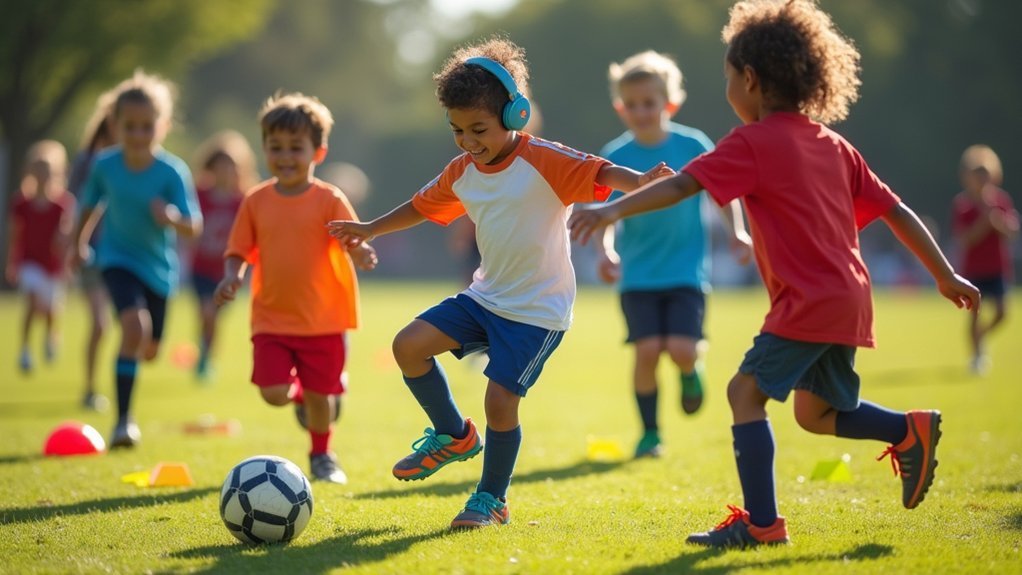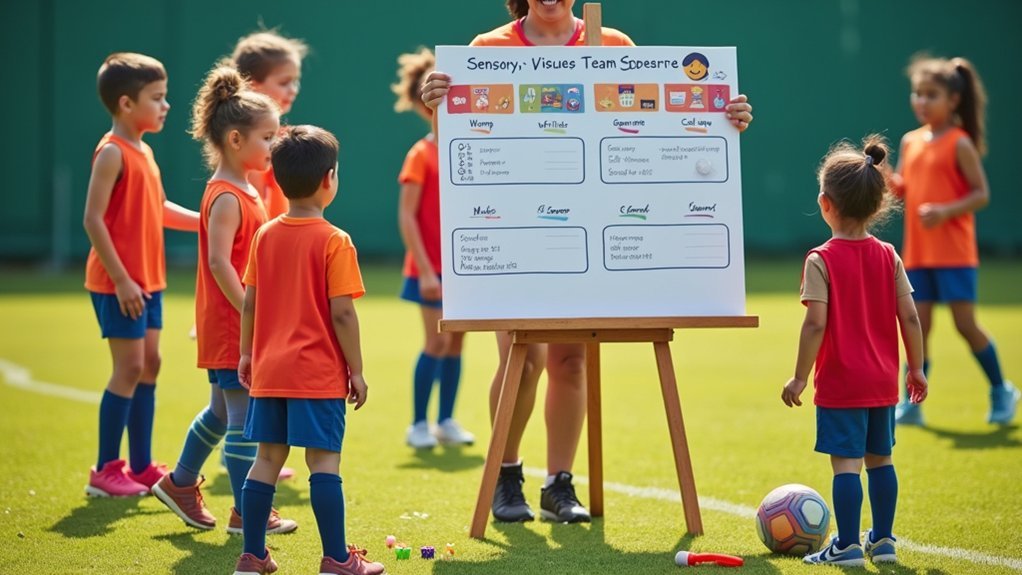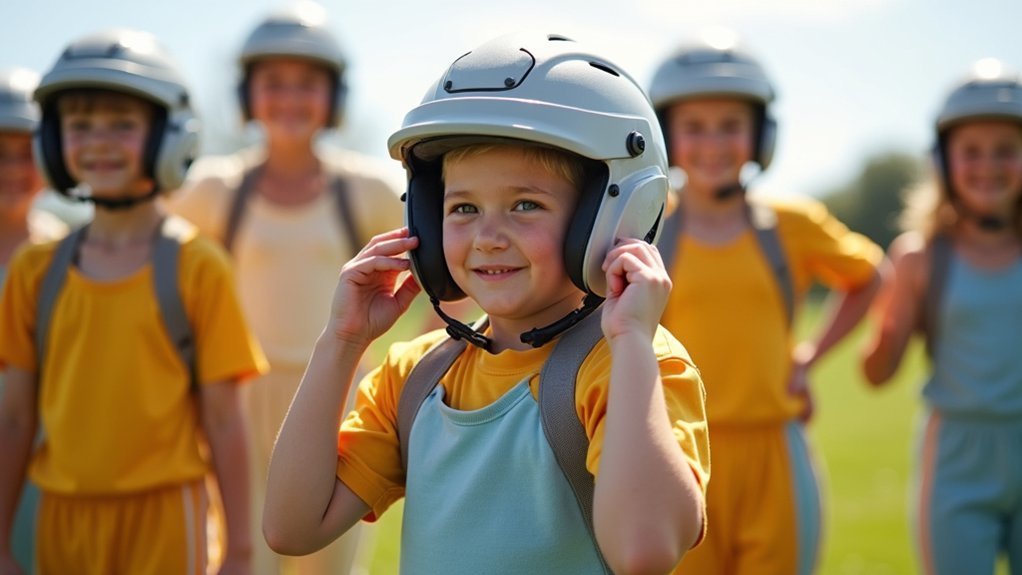When creating sensory-friendly sports experiences, you’ll need thoughtful adaptations. Establish consistent routines with clear visual schedules. Choose equipment with soft, breathable materials and minimal seams. Create designated quiet zones for sensory breaks. Use visual boundaries to define personal space during play. Implement a break signal system for overwhelmed players. Adapt uniforms with natural fabrics and tag-free options. Select smaller group sizes with modified rules. These adjustments can transform a challenging activity into an enjoyable team experience.
7 Tips For Sensory-Friendly Team Sports Success

While team sports offer valuable social and physical benefits, they can present unique challenges for children with sensory processing disorder. Creating an inclusive environment starts with structure.
Establish consistent practice routines with clear warm-up and cool-down periods to help children navigate smoothly. Incorporate sensory breaks where participants can step away when feeling overwhelmed, allowing them to reset before rejoining physical activity.
Consider adapting games with smaller group sizes and modified rules that accommodate different skill levels. Use visual markers to define personal space, helping children understand boundaries during play.
Encourage open dialogue between coaches, parents, and players about sensory needs. When teammates understand each other’s challenges, they can develop respect and support that makes sports enjoyable for everyone involved.
Choosing the Right Equipment for Sensory Comfort
Beyond creating an inclusive environment, the right equipment can make or break a child’s sports experience. When selecting protective gear for sensory-sensitive athletes, prioritize soft, breathable materials that won’t trigger discomfort.
| Equipment Type | Sensory-Friendly Features |
|---|---|
| Shin Guards | Soft, breathable fabrics with minimal seams |
| Athletic Protection | Non-irritating materials, comfort-focused design |
| Uniforms | Natural fabrics, tag-free options, loose fit |
| Footwear | Adjustable closures, minimal pressure points |
Include your child in equipment selection—this empowers them and increases acceptance. Test multiple options since sensory preferences vary widely between children. Pay attention to how gear fits overall, ensuring it doesn’t restrict movement or cause anxiety. Finding the right sensory-friendly equipment often requires experimentation, but the payoff is a more comfortable and confident young athlete.
Creating Predictable Routines and Visual Schedules

For children with sensory sensitivities, predictability serves as a foundation for success in team sports. Establishing consistent routines helps your child feel secure and less anxious, allowing them to focus on developing skills rather than managing uncertainty.
Create visual schedules that outline practice and game activities using color-coded charts or pictures. These visual supports make shifts clearer and help your child understand what comes next. Include regular warm-up and cool-down sequences that provide a structured framework supporting sensory regulation.
Review and update these visual schedules with your child regularly. This collaborative approach builds ownership and makes adapting to occasional changes easier.
When your child can anticipate what’s happening, they’ll participate more confidently and enjoy the social benefits of team sports.
Establishing Quiet Zones for Sensory Breaks
Set up dedicated quiet zones away from main activities where children can retreat when feeling overwhelmed during sports participation.
Equip these calming spaces with sensory tools like noise-canceling headphones, weighted blankets, and soft seating that help participants self-regulate.
Implement a simple break signal system that allows children to communicate their need for a sensory break without drawing unwanted attention.
Zone Setup Guidelines
Creating effective quiet zones is essential for inclusive team sports environments where children with sensory needs can decompress. Designate an area away from the main activity that’s still easily accessible for children who need breaks from overwhelming sensory input.
Clearly mark your quiet zone with visual boundaries using cones or colorful signs that help children identify this safe space. Stock the area with comfort essentials: noise-canceling headphones, soft seating options, and various fidget toys that provide calming sensory experiences.
Establish consistent break routines and openly communicate the quiet zone’s availability to everyone involved—coaches, participants, and parents. This normalization helps children feel comfortable using the space when needed, without stigma.
When properly implemented, these zones become valuable resources that support participation and enjoyment for all children.
Designating Calming Spaces
While active participation remains the goal for inclusive sports programs, establishing dedicated calming spaces provides essential support for children with sensory sensitivities. You’ll want to create zones with comfortable seating, low lighting, and minimal stimuli where participants can regroup when feeling overwhelmed.
| Calming Space Element | Implementation Tip |
|---|---|
| Location | Position in low-traffic, quiet areas |
| Signage | Use clear, simple visuals to identify zones |
| Equipment | Provide fidget tools, headphones, and soft seating |
| Access System | Implement signals children can use to request breaks |
| Feedback Loop | Regularly check how well spaces meet sensory needs |
Empower children by teaching them to recognize when they need a sensory break and how to use these spaces effectively. By normalizing these retreats, you’re helping participants develop self-regulation skills while ensuring they can return to activities refreshed.
Break Signal Systems
Effective communication during moments of sensory overload requires a well-designed break signal system that everyone on the team understands.
Establish consistent hand gestures or sounds that clearly indicate when a player needs a sensory break. These signals should be simple enough to use during high-stress moments without drawing unnecessary attention.
Make sure all coaches, players, and support staff recognize these signals and respond appropriately.
When implementing break signal systems, pair them with designated quiet zones where players can retreat. This creates a complete support structure that normalizes sensory breaks as part of your team’s routine.
Schedule regular breaks during practices and games, and foster an environment where requesting additional breaks isn’t stigmatized.
When players know they can easily communicate their needs, they’ll perform better and enjoy sports more fully.
Modifying Communication Methods for Team Coordination
Because sensory processing differences can impact how athletes receive and interpret instructions, adapting communication strategies becomes essential for inclusive team sports. Your communication approach should incorporate visual supports alongside verbal instructions to guarantee all team members can process information effectively.
Inclusive coaching demands multi-sensory communication to ensure every athlete fully understands and excels regardless of processing differences.
Create a support team environment where players feel comfortable expressing their communication preferences by:
- Using clear, concise language paired with visual diagrams or color-coded playbooks to enhance understanding of complex plays.
- Establishing consistent hand signals or visual cues for on-field communication, especially helpful in noisy game environments.
- Implementing role-playing scenarios to prepare athletes for game situations, reducing anxiety around social interactions.
Regularly check in with players to assess which communication methods work best, adjusting your approach as needed.
Adapting Uniforms and Gear for Sensory Sensitivities

You’ll find that selecting soft, breathable fabrics can transform a child’s sports experience from uncomfortable to enjoyable.
Consider involving your child in choosing their uniforms and protective equipment, allowing them to test different brands until they find options that don’t trigger sensory discomfort.
When necessary, don’t hesitate to explore personalized modifications like custom shin guards or padded sleeves that provide protection while respecting your child’s unique sensory needs.
Comfort Without Compromises
When children with sensory sensitivities participate in team sports, standard uniforms and equipment can become significant barriers rather than helpful tools.
Selecting the right gear can help create a comfortable experience without sacrificing protection or team identity.
To balance comfort with sports requirements:
- Choose soft, breathable fabrics for uniforms that won’t trigger discomfort or overheating during physical activity.
- Explore alternative protective gear options like custom-designed shin guards that prioritize both safety and sensory comfort.
- Involve your child in selecting their equipment to increase acceptance and give them a sense of control.
Test multiple brands and styles since sensory experiences vary between products.
Introduce new gear gradually in relaxed settings, allowing your child to associate their equipment with positive experiences rather than stress.
Personalized Equipment Adjustments
While standard sports gear works for most athletes, children with sensory sensitivities often need thoughtful modifications to their uniforms and equipment. Prioritize soft, breathable fabrics that won’t trigger negative reactions during play. Many physical therapy professionals recommend compression wear that provides beneficial sensory input while maintaining comfort.
| Equipment Type | Personalized Adjustment |
|---|---|
| Uniforms | Choose moisture-wicking, soft fabrics without tags |
| Protective Gear | Select sensitivity-designed shin guards with reduced irritation |
| Footwear | Find seamless socks and supportive shoes with proper fit |
| Compression Items | Utilize as recommended by physical therapy for calming effect |
| Team Accessories | Let child select visually appealing items they feel comfortable wearing |
Involve your child in equipment selection—their input matters most. Test different brands and styles, making adjustments until you find the perfect personalized equipment that enhances their enjoyment rather than distracting from it.
Designing Progressive Skill-Building Activities
Learning complex team sports skills can overwhelm sensory-sensitive athletes, particularly when all components are introduced simultaneously. Break down sports movements into smaller, manageable steps that build upon each other. This occupational therapy-inspired approach helps players master fundamentals before tackling more complex actions.
Incorporate diverse teaching methods to address different learning preferences:
- Visual demonstrations – Show the skill slowly, then at regular speed
- Guided physical practice – Provide hands-on assistance that gradually decreases
- Structured repetition – Create predictable skill-building activities with consistent routines
As players gain confidence, gradually increase difficulty by adding time constraints, defensive pressure, or combining movements.
Schedule regular assessment periods to track progress and adjust your approach. This methodical progression builds competence while respecting each athlete’s sensory processing needs.
Frequently Asked Questions
What Is the Best Sport for Sensory Issues?
There’s no single “best” sport for sensory issues. You’ll want to contemplate individual sports like swimming or martial arts that provide structure while minimizing overwhelming stimuli. Your child’s specific sensory needs should guide your choice.
Can Kids With SPD Play Sports?
Yes, your child with SPD can definitely play sports. They’ll succeed most in activities matching their sensory profile. Individual sports like swimming and martial arts often work well, but with proper support, team sports are possible too.
What Sport Is Best for an Autistic Child?
Consider individual sports like swimming, martial arts, or track and field for your autistic child. They’re structured, self-paced, and don’t require complex social interaction. Always choose based on your child’s specific sensory sensitivities and interests.
What Is the Best Martial Arts for Sensory Seekers?
For sensory seekers, you’ll find Jiu Jitsu particularly beneficial as it provides intense physical contact and push/pull engagement. Muay Thai also works well if you’re seeking strong impact feedback through striking techniques.
In Summary
Remember, you’re not just building athletic skills—you’re creating a space where everyone can thrive. With these sensory-friendly approaches, you’ll watch players grow in confidence, social connections, and sports abilities. By tailoring the environment to meet diverse sensory needs, you’re ensuring that team sports become a positive experience for all participants. That’s the real victory, regardless of the scoreboard.





Leave a Reply